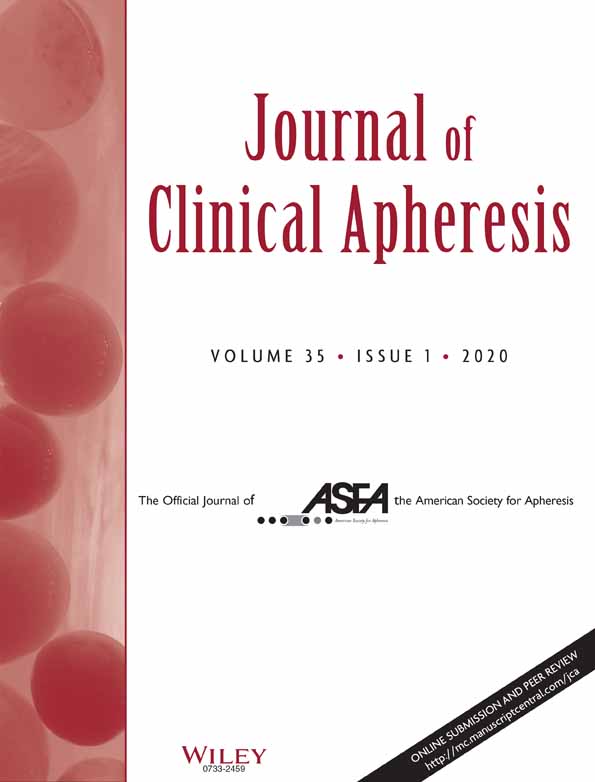Exclusive use of PowerFlow ports may not be appropriate for all patients
Corresponding Author
Lance A. Williams III
Division of Laboratory Medicine, Department of Pathology, The University of Alabama at Birmingham, Birmingham, Alabama
Correspondence
Lance A. Williams, University of Alabama at Birmingham, Department of Pathology, Division of Laboratory Medicine, 619 19th Street S, WP-P230F, Birmingham, AL 35249.
Email: [email protected]
Search for more papers by this authorMichael N. Boshell
Infusion Services, Therapeutic Apheresis, The University of Alabama at Birmingham, Birmingham, Alabama
Search for more papers by this authorJill Adamski
Department of Laboratory Medicine and Pathology, Mayo Clinic, Phoenix, Arizona
Search for more papers by this authorHuy P. Pham
Department of Pathology, Keck School of Medicine, University of Southern California, Los Angeles, California
Search for more papers by this authorBryan Guillory
Division of Laboratory Medicine, Department of Pathology, The University of Alabama at Birmingham, Birmingham, Alabama
Search for more papers by this authorJames Sikora
Division of Laboratory Medicine, Department of Pathology, The University of Alabama at Birmingham, Birmingham, Alabama
Search for more papers by this authorStephanie Lisby
Infusion Services, Therapeutic Apheresis, The University of Alabama at Birmingham, Birmingham, Alabama
Search for more papers by this authorAshley Lovingood
Infusion Services, Therapeutic Apheresis, The University of Alabama at Birmingham, Birmingham, Alabama
Search for more papers by this authorX. Long Zheng
Division of Laboratory Medicine, Department of Pathology, The University of Alabama at Birmingham, Birmingham, Alabama
Search for more papers by this authorMarisa B. Marques
Division of Laboratory Medicine, Department of Pathology, The University of Alabama at Birmingham, Birmingham, Alabama
Search for more papers by this authorCorresponding Author
Lance A. Williams III
Division of Laboratory Medicine, Department of Pathology, The University of Alabama at Birmingham, Birmingham, Alabama
Correspondence
Lance A. Williams, University of Alabama at Birmingham, Department of Pathology, Division of Laboratory Medicine, 619 19th Street S, WP-P230F, Birmingham, AL 35249.
Email: [email protected]
Search for more papers by this authorMichael N. Boshell
Infusion Services, Therapeutic Apheresis, The University of Alabama at Birmingham, Birmingham, Alabama
Search for more papers by this authorJill Adamski
Department of Laboratory Medicine and Pathology, Mayo Clinic, Phoenix, Arizona
Search for more papers by this authorHuy P. Pham
Department of Pathology, Keck School of Medicine, University of Southern California, Los Angeles, California
Search for more papers by this authorBryan Guillory
Division of Laboratory Medicine, Department of Pathology, The University of Alabama at Birmingham, Birmingham, Alabama
Search for more papers by this authorJames Sikora
Division of Laboratory Medicine, Department of Pathology, The University of Alabama at Birmingham, Birmingham, Alabama
Search for more papers by this authorStephanie Lisby
Infusion Services, Therapeutic Apheresis, The University of Alabama at Birmingham, Birmingham, Alabama
Search for more papers by this authorAshley Lovingood
Infusion Services, Therapeutic Apheresis, The University of Alabama at Birmingham, Birmingham, Alabama
Search for more papers by this authorX. Long Zheng
Division of Laboratory Medicine, Department of Pathology, The University of Alabama at Birmingham, Birmingham, Alabama
Search for more papers by this authorMarisa B. Marques
Division of Laboratory Medicine, Department of Pathology, The University of Alabama at Birmingham, Birmingham, Alabama
Search for more papers by this author
REFERENCES
- 1Ipe T, Marques MB. Vascular access for therapeutic plasma exchange. Transfusion. 2018; 58(suppl 1): 580-589. https://doi.org/10.1111/trf.14479.
- 2Golestaneh L, Mokrzycki MH. Vascular access in therapeutic apheresis: update 2013. J Clin Apher. 2013; 28: 64-72.
- 3Adamski J. Vascular access considerations for extracorporeal photopheresis. Transfusion. 2018; 58(suppl 1): 590-597. https://doi.org/10.1111/trf.14500.
- 4Ryan MJ. Approval letter: PowerFlow implantable apheresis IV port. Silver Spring (MD): Food and Drug Administration; 2017. https://www.accessdata.fda.gov/cdrh_docs/pdf16/K163001.pdf. Accessed October 21, 2018.
- 5PowerFlow implantable apheresis IV port [Internet]. Tempe (AZ): Bard Peripheral Vascular, Inc.; 2017. http://www.bardpv.com/wp-con-tent/uploads/2017/05/BPV-PRT3-1016-0002-1-v1.1-Power-Flow-Brochure.pdf. Accessed October 21, 2018.
- 6Williams LA, Arnesen C, Gunn C, et al. New subcutaneous PowerFlow port results in cost and time-savings in a busy outpatient apheresis clinic. J Clin Apher. 2019; 34(4): 482–486. https://doi.org/10.1002/jca.21678.
- 7Clase CM, Crowther MA, Ingram AJ, Cina CS. Thrombolysis for restoration of patency to haemodialysis central venous catheters: a systematic review. J Thromb Thrombolysis. 2001; 11: 127-136.




